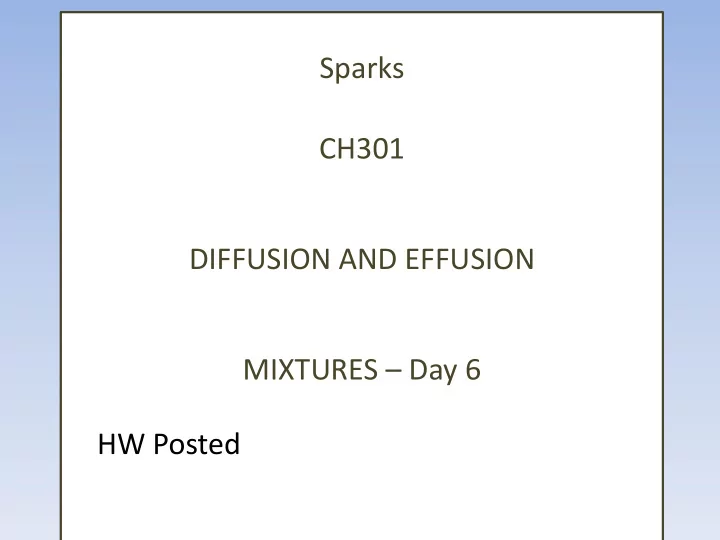

Sparks CH301 DIFFUSION AND EFFUSION MIXTURES – Day 6 HW Posted
What did we learn last time? Ideal Gas is amazing – empirically derived and also theoretically derived. We now know how to relate rms velocity to both temperature and mass Finally, there is a distribution of velocities. This will have huge implications for future understanding of chemistry!
Demo Let ’ s think about our demo. What is the ratio of the speeds of the two molecules in our demo? NH 3 : HCl Numerical Question: Give an answer to one decimal place
Standard Molar Volume One mole of any ideal gas occupies 22.4 L at STP Most real gases have standard molar volumes within 2% of this value.
Try it Out! Avogadro Example 1 What is the density of CO 2 gas at STP? A. 1.96 g/L B. 44 g/L C. 0.05 g/L D. 1050 g/L
Engaging in practice matters… Illusion of Understanding • Watching isn ’ t the same as doing Maximize Learning Opportunities • test your understanding • make mistakes • receive coaching
What are we going to learn today? EFFECT OF VELOCITY ON DIFFUSION AND EFFUSION REPRESENTING GAS MIXTURES Concept of Partial Pressures
Diffusion and Effusion Diffusion: Spread of particles due to random motion (perfume “ smell ” wander across the room) Effusion: Loss of gas from a container through a small pore. (He balloon that deflates slowly) Both directly related to the velocity of the gas particles
Effusion
POLL: CLICKER QUESTION You have two gases under identical conditions. One gas has a density that is double that of the other gas. What is the ratio of the rate of diffusion of the high density gas compared lower density gas A. 2 times less B. Sqrt(2) times less C. 2 times faster D. sqrt(2) times faster E. they are identical
Figure 5.20: Uranium-enrichment converters from the Paducah gaseous diffusion plant in Kentucky. Actually- this is technically effusion...!
MASS DENSITY FOR GASES THINK BACK TO BALLOONS SAME T & P DIFFERENT DENSITIES WERE DUE TO THE DIFFERENT MASSES OF THE GAS “ PARTICLES ” WHAT ABOUT MIXTURES?
How to describe a mixture Two containers of equal volume separated by a wall n He = mole He n Ar = mole Ar T = 300K T = 300K P = 1 bar P = 1 bar
Groupwork quiz Mixtures Remove the wall. What is the total pressure?
Partial Pressure Total pressure is still 1 bar Where does the pressure come from? We can think of dividing it up into the pressure from the He and the pressure from the Ar.
Mixtures Half the particles are Ar so half the pressure should be from Ar
Mixtures The same is true for He P He = n He RT/V n He is half the number of total moles So P He is half the total pressure
Partial Pressure This is what we call “ partial pressure ” In a mixture, the partial pressure of gas “ i ” P i = n i RT/V
Dalton ’ s Law The sum of all partial pressure must be the total pressure
Mole Fraction Percentage What fraction of the particles are gas “ i ” ?
Mole Fraction Percentage What fraction of the particles are gas “ i ” ? Mole fraction X i is the number of moles i divided by the total number of moles
Mole Fraction Percentage What fraction of the particles are gas “ i ” ? Mole fraction X i is the number of moles i divided by the total number of moles
Mole Fraction Percentage What fraction of the particles are gas “ i ” ? Mole fraction X i is the number of moles i divided by the total number of moles
Mole Fraction Percentage What fraction of the particles are gas “ i ” ? Mole fraction X i is the number of moles i divided by the total number of moles
Mole Fraction Percentage What fraction of the particles are gas “ i ” ? Mole fraction X i is the number of moles i divided by the total number of moles
Two tanks are connected by a closed valve. Tank A, filled with O 2 , has a volume of 2 L and a pressure of 5 atm. Tank B, filled with N 2 , has a volume of 4 L and a pressure of 10 atm. The valve is opened. What is 1. The partial pressure exerted by oxygen? 2. The total pressure exerted by the mixture? 3. What is the mole fraction of nitrogen? Report each answer to one decimal place
What did we learn today? We can apply our knowledge of velocities to diffusion and effusion of gases We can utilize the idea of partial pressures and mole fractions to understand more about a gas sample.
DAY 6 LEARNING OUTCOMES Perform calculations to determine the mole fractions of gases within and gas mixture and relate mole fraction to the partial pressure of a gas within a gas mixture. Describe the relationship between partial pressures and the total pressure as described in Dalton ’ s Law of Partial Pressure.
Recommend
More recommend